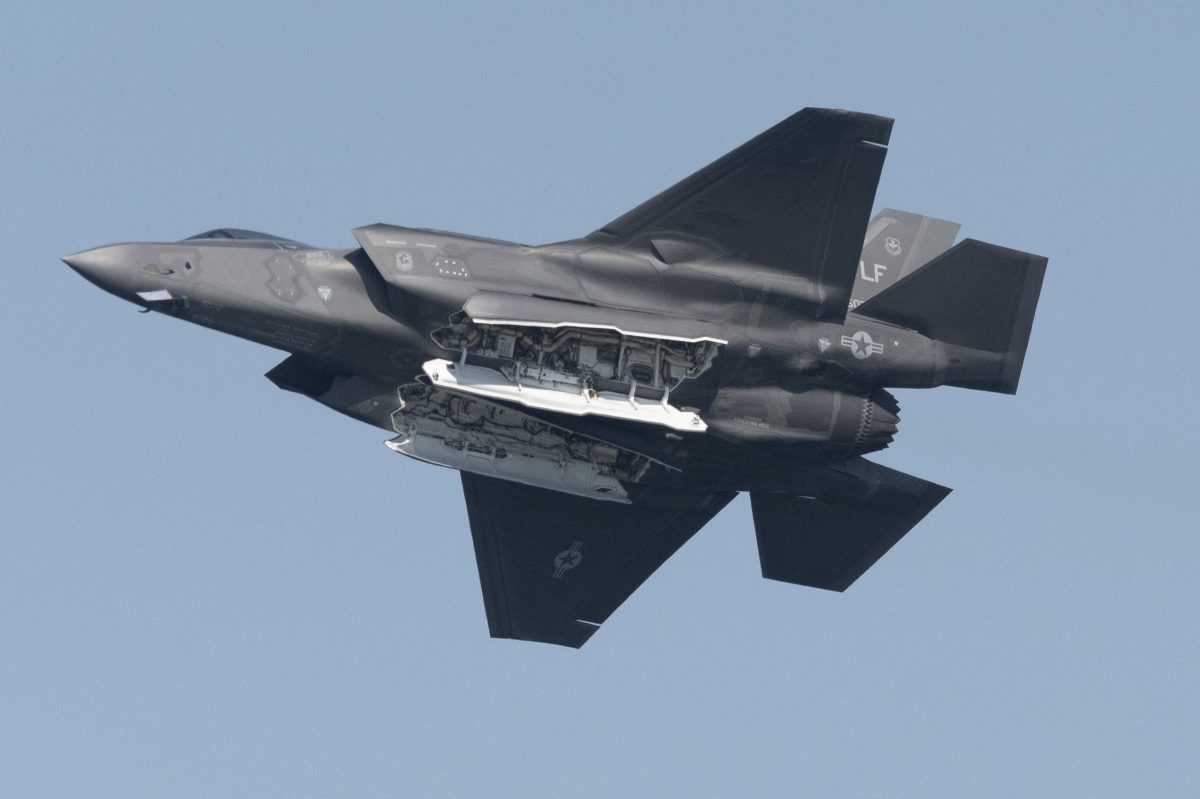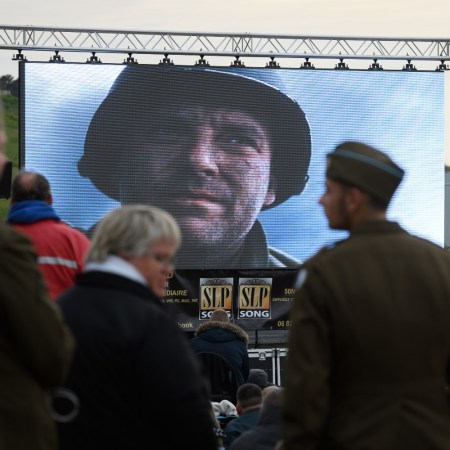The following is an excerpt from F-35: The Inside Story of the Lightning II by Tom Burbage, Betsy Clark and Adrian Pitman. Copyright © 2023. Available from Skyhorse Publishing, a registered trademark of Skyhorse Publishing, Inc., a Delaware corporation.
You start the engine. Its turbine spools upward with a whine, quickly growing into a deafening roar that seeps through your helmet’s sound protection and vibrates through your soul.
And just like that, you’re superhuman. Like Argus, the farsighted, manyeyed watchman of Greek myth. The helmet-mounted display lets you see the contours of the land, far to the west. Every ship and plane and terrain feature for hundreds of miles around. The helmet feeds you warmed oxygen, maintains pressure even if the cockpit’s shattered by enemy fire, and scrubs the carbon dioxide from your breath. Essentially, you’re wearing a space suit. The helmet of this one, however, also has a media room built in. High-definition cameras surface mounted within the aircraft’s fuselage feed live video to a mission computer. The computer stitches the entire 360-degree surround into a single scene that seamlessly follows your head movement. You don’t see the aircraft you’re sitting in. Instead, you’re suspended in space. When you look down now, you see the ship’s deck beneath you.
The aircraft you’re warming up for combat is the first true fifth-generation multi-role, multiservice coalition fighter.
But even that term is a misnomer. A “fighter” isn’t all the Lightning is, by a long shot. The F-35’s talent at instantaneously collecting, analyzing, then sharing information across a whole theater of war—day and night, in any weather, while remaining hidden from enemy defenses or countermeasures—makes it far more.
During World War II, it took weeks of research, planning, rehearsal, and thousands of men and women—spies, radar operators, SIGINT interpreters, observers, plotters, high-altitude reconnaissance, photo analysts, then the pilots, navigators, gunners, and bombardiers of hundreds of bomber aircraft and escorting fighters—to destroy one high-value enemy target . . . such as a ballbearing factory.
This single aircraft you’re sitting in could have destroyed the entire plant complex at Schweinfurt, Germany, on its own. In minutes. And never have been spotted.
It could have detected, localized, and shattered the tanks of the 21st Panzer Division as they clanked toward the beach at Normandy. All on its own.
It could have evaded the Nazi radar and early warning systems, detected the buried bunker in Berlin, and killed the genocidal dictator in his subterranean lair with one concrete-penetrating bomb.
A flight of four Lightning IIs could have done all these things, and ended that war, on the same mission.
While you were belting in, the plane’s internal diagnostics have been busy. Nearly 1,200 hardware components share software handshakes in seconds to ensure mission readiness. You don’t need to compare dozens of dials to a checklist, or cycle rudder or ailerons. Any flaw or fault will be presented automatically on your screen. A glance is all you need to reassure yourself all systems are go.
From Polo Players to World War II Soldiers, Exploring the History of the Desert Boot
How the ubiquitous shoe came to be adored all over the worldOut on the deck, you spot the Fly 1 Petty Officer responsible for the silentlaunch process. You turn on your wingtip lights, signaling you’re ready to go. He touches the deck with his covert night wand, clearing you to launch.
You check the screen one last time and advance the throttle to full power.
Heavier-than-air flight has always depended on engines. The Wright brothers’ four-cylinder aluminum-block engine, more powerful for its weight than any before, allowed them to finally lurch a few yards into the air. That pitifully primitive power plant generated a whopping twelve horsepower.
But behind you now, a Pratt & Whitney F135 radar and infrared stealthy afterburning jet engine is spooling up to generate 43,000 pounds of thrust. Thirty thousand horsepower, 2,500 times more muscle than the Wrights had. The most powerful fighter engine ever built, and the most complex.
You’ll need every erg to get aloft. Almost half of the aircraft around you is fabricated of advanced structural composites, including lighter-weight epoxies in which carbon nanotubes are embedded. But it still weighs sixty thousand pounds. About a quarter of that is fuel. Your internal weapon bays are loaded with two tons of air-to-ground and air-to-air weapons. Once enemy air defenses are mitigated, you can also carry weapons externally, on pylons, at the sacrifice of some stealth.
A large rear-opening door lifts behind the cockpit, exposing a ducted fan. The noise builds to a roar, only partially masked by the helmet and cockpit soundproofing. You begin your takeoff roll to generate early lift over the wings. The engine nozzle swings down, adding its thrust to that of the counterrotating lift fan They both strain to bench-press thirty tons of fuel, electronics, weapons, airframe, and pilot.
As the deck quickly recedes, you’re airborne and accelerating. The lift fan disengages, and the lift-fan door slowly closes. Your F-35B is now nearly identical to any other advanced enemy fighter in the up-and-away flight regime.
The ship shrinks to a gray dot in a black, wind-whipped sea.
Aloft, your sensors sharpen. Your view reaches out literally hundreds of miles. Your consciousness expands in a vast sphere. Multi-spectrum sensors on wings and fuselage stream data into your computers, interpreting infinitesimally minute pulses of radar and visible and infrared light into actionable intelligence. Even far from the approaching coast, you can peer deep inland. You can make out individual tanks parked in a dense forest. You can distinguish actual missile batteries from inflated dummies. Or identify and track aircraft or drones, even those flying at treetop level.
And you’re not alone. Every allied ship, plane, and ground force in the entire battlespace is an information-sharing node, and you know and see everything they do.
A warning tone sounds in your earphones, and a scarlet symbol winks to life on your helmet visor. The plane’s calling your attention to a possible threat. You zoom in with electro-optics. A patrol boat’s lurking in a mangrove swamp off the coast you’re approaching. Your systems identify it as enemy. You agree, tag it for destruction, and hand off the info to a British carrier far to seaward of you, maintaining a combat air patrol. Within minutes, a British F-35B, acting on your targeting information, releases a smart bomb. A massive blast strews fire, fragments, and torn-apart bodies across the hidden stream and into the jungle.
Half an hour later you’re headed back. Not for the ship, but to land on a captured island. It pushes up over the horizon, a dreadfully short strip of asphalted road that would take the pilot of any other aircraft hundreds of flight hours to dare tackling. All you need to do is line up, press a button on your throttle, and the plane holds approach landing speed and the proper angle of attack. You nudge it a bit to correct for wind. You’ve used up most of your fuel and expended most of your ordnance, putting the jet in the envelope for a vertical landing. You touch down exactly on the designated point and as the wheels thump to the ground, the engine drops to idle.
You’ve just flown a sample mission in the F-35. Now you understand why the “Lightning II,” also known as the Joint Strike Fighter, is the most advanced aircraft ever built. The most capable single plane that flies in the world today. Also, the most complex. It’s been called “the costliest and most technically challenging weapons program the Pentagon has ever attempted.”5 Running the mission you just returned from required nearly 9 million lines of computer code and thousands of person-years of coding and debugging. To put that in perspective, the Apollo 11 Lander required only 145,000 lines of code, and NASA’s Mars Curiosity Rover about 2.5 million.
Today, it’s the future of both air defense and offensive operations for all of the original partners, with the exception of Turkey, which was kicked out of the program in 2019 after buying Russian’s S-400 missile defense system. That makes a dozen nations: the United States, Britain, the Netherlands, Italy, Israel, Australia, Denmark, Japan, Norway, South Korea, Canada, and Singapore. In addition, following the Russian invasion of Ukraine, Poland, Belgium, Finland, Switzerland, Germany, and others are now lining up to be part of the F-35 alliance. To date, the F-35 has not lost a competitive evaluation by any allied air force.
This article was featured in the InsideHook newsletter. Sign up now.

























